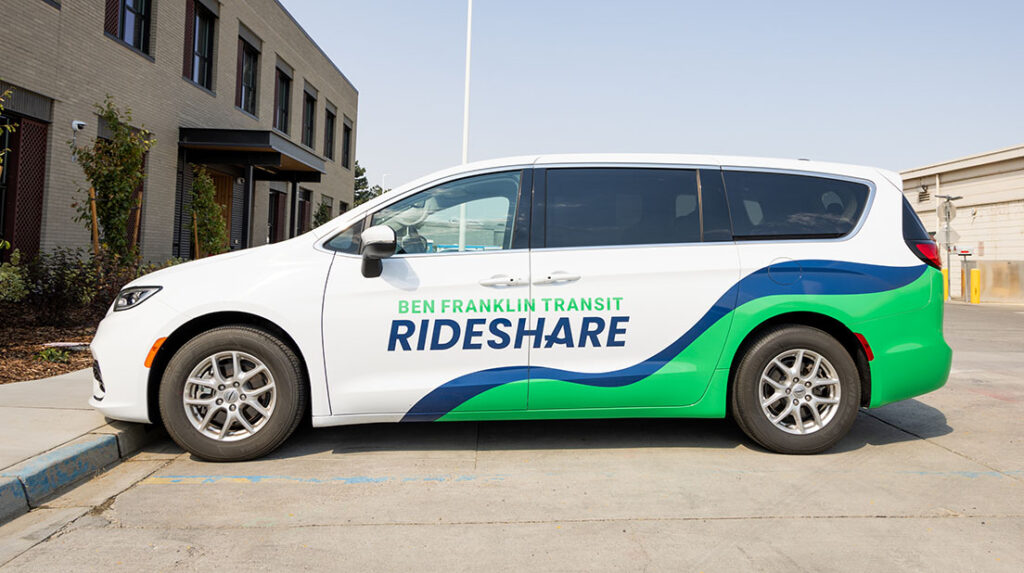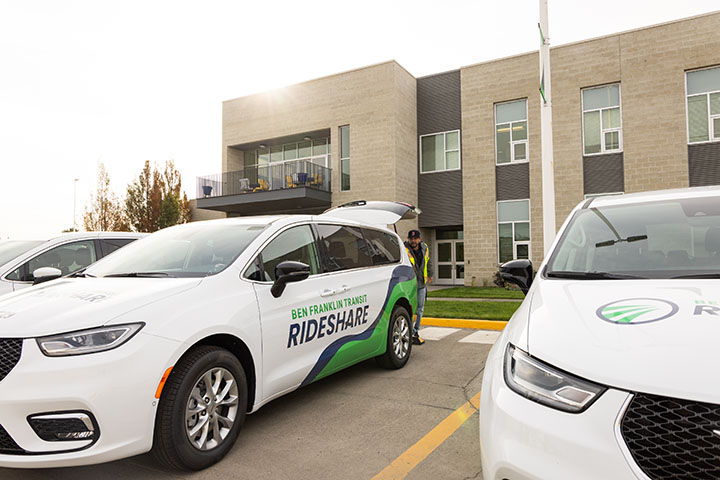Why Rideshare?

RIDESHARE (formerly Vanpool)
It’s your commute, only better. By joining a Ben Franklin Transit (BFT) Rideshare, you will reduce the cost, stress, and environmental impact of your commute!
Rideshare is a group of 5 to 15 people who commute together in a comfortable 6-, 12-, or 15-passenger vanA small vehicle, usually 20 feet or shorter in length, with an automotive-type engine and limited seating normally entered directly through side or rear doors rather than from a central aisle. Used for door-to-door and other specialized transit services. More owned, maintained, insured, and licensed by BFT. If your commute begins or ends within BFT’s service area, Rideshare can work for you. Locations currently being served include the Hanford site, Connell, Pendleton, Walla Walla, and Paterson.
Interested in learning more? Contact our Rideshare team at 509.943.5442 or vanpool@bft.org.
Is Rideshare the right choice for me?
When you use Rideshare, you:
- Keep more money in your pocket. Rideshare saves you money on gas, oil, insurance, and wear and tear on your personal vehicle.
- De-stress your commute. Sit back, relax, nap, or catch up on the latest news while enjoying the daily ride to and from work.
- Help the environment. Reduce the number of vehicles on the road and cut carbon emissions.
How does it work?
You need at least five commuters to start and maintain a Rideshare group. Each group must have a coordinator/bookkeeper and two drivers. BFT must approve and train drivers before they operate the Rideshare vehicle.
Rideshare passengers pay a low monthly fare depending on mileage and the number of riders in the vanA small vehicle, usually 20 feet or shorter in length, with an automotive-type engine and limited seating normally entered directly through side or rear doors rather than from a central aisle. Used for door-to-door and other specialized transit services. More. Fares cover the van’s operating costs, including fuel, insurance, and maintenance. You pay your fare at the beginning of each month to reserve your seat but aren’t required to ride daily.
The group sets its rules, including pick-up and drop-off locations and commute schedules.
How do I start one?
To enlist at least five riders, post signs around your building and discuss the opportunity with coworkers and friends; we will gladly assist you in finding passengers. Once you have enough riders, call us, and we will help you through the following steps:
- Map out a route.
- Decide on pick-up and drop-off points.
- Determine a schedule.
- Choose someone to coordinate the Rideshare group.
- Choose a bookkeeper to collect fares.
- Choose at least two people to drive. Driver applicants must meet specific requirements; we will screen and approve driver applications.
- Sign up drivers for our Rideshare Driver Training.
- Have all participants complete and sign a rider agreement.
Can I join an existing one?
Yes, you can! How do you join?
- If you see a vanA small vehicle, usually 20 feet or shorter in length, with an automotive-type engine and limited seating normally entered directly through side or rear doors rather than from a central aisle. Used for door-to-door and other specialized transit services. More at work, please contact us with the van’s number, and we can connect you with the relevant group.
- Let us help find you one by telling us where you want to start, where you want to go, and when.
How much does it cost?
The monthly fares are based on the number of round-trip miles traveled daily, the number of days worked based on your shift, and the number of riders in the vanA small vehicle, usually 20 feet or shorter in length, with an automotive-type engine and limited seating normally entered directly through side or rear doors rather than from a central aisle. Used for door-to-door and other specialized transit services. More.
For example, ten people traveling 70 miles daily and working 4-10’s would be responsible for collecting $645.30 a month, or $64.53 per person. That breaks down to less than $0.06 per person per mile per month for this commute.
Wintertime Defensive Driving
As the weather gets colder and snow and ice are in the forecast, proper preparation and defensive driving skills become imperative to preventing collisions.
- Prepare for the drive: Before leaving your location in the morning, ensure you are prepared for the road. Clear ice and snow from your vehicle and double-check that you have the necessary cold-weather supplies, such as an ice scraper, shovel, and ice melt.
- Winter driving: When slick conditions are present, never use cruise control and ensure you maintain a proper following distance. Remember, the combination of the vehicle’s size and weight, along with adverse weather conditions, can significantly increase your stopping distance.
When you leave room in front of your vanA small vehicle, usually 20 feet or shorter in length, with an automotive-type engine and limited seating normally entered directly through side or rear doors rather than from a central aisle. Used for door-to-door and other specialized transit services. More to account for adverse conditions, remember to leave room around all sides. This extra room can prevent collisions with other vehicles and fixed objects.
With proper preparation and the use of your safe driving skills, you can prevent winter-time vehicle collisions.
For Rideshare Users
Rideshare Rate Charts
 6-Passenger VanA small vehicle, usually 20 feet or shorter in length, with an automotive-type engine and limited seating normally entered directly through side or rear doors rather than from a central aisle. Used for door-to-door and other specialized transit services. More
6-Passenger VanA small vehicle, usually 20 feet or shorter in length, with an automotive-type engine and limited seating normally entered directly through side or rear doors rather than from a central aisle. Used for door-to-door and other specialized transit services. More
 12-Passenger VanA small vehicle, usually 20 feet or shorter in length, with an automotive-type engine and limited seating normally entered directly through side or rear doors rather than from a central aisle. Used for door-to-door and other specialized transit services. More
12-Passenger VanA small vehicle, usually 20 feet or shorter in length, with an automotive-type engine and limited seating normally entered directly through side or rear doors rather than from a central aisle. Used for door-to-door and other specialized transit services. More
 15-Passenger VanA small vehicle, usually 20 feet or shorter in length, with an automotive-type engine and limited seating normally entered directly through side or rear doors rather than from a central aisle. Used for door-to-door and other specialized transit services. More
15-Passenger VanA small vehicle, usually 20 feet or shorter in length, with an automotive-type engine and limited seating normally entered directly through side or rear doors rather than from a central aisle. Used for door-to-door and other specialized transit services. More
For more information, please get in touch with our Rideshare team at 509.943.5442 or vanpool@bft.org.



